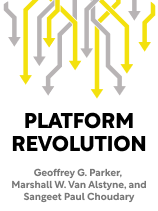

This article is an excerpt from the Shortform book guide to "Platform Revolution" by Geoffrey G. Parker, Marshall W. Van Alstyne, and Sangeet Paul Choudary. Shortform has the world's best summaries and analyses of books you should be reading.
Like this article? Sign up for a free trial here.
What makes businesses like Amazon and Spotify successful? How can you start your own platform?
In Platform Revolution, the authors compare the platform business model to the traditional business model known as a pipeline. They also outline the essential design and management strategies for platform developers.
Read below for a brief Platform Revolution book overview.
What’s Platform Revolution About?
Have you ever wondered what makes platform businesses like X (formerly known as Twitter), Spotify, and Amazon so successful? In the Platform Revolution book (2016), economists Geoffrey G. Parker and Marshall W. Van Alstyne and businessman Sangeet Paul Choudary provide the answer: Platform businesses leverage their novel characteristics to become uniquely competitive and transformative, with far-reaching effects on the economy, society, and politics. The authors also explain that running a platform business requires a distinct skill set—so in case you want to start your own platform business, they provide design and management tips to help you achieve success.
Parker and Van Alstyne are prolific and widely-celebrated researchers who received the 2019 Thinkers50 Digital Thinking Award for their pioneering research on platform businesses and digital economics. Choudary now applies his platform expertise as a business consultant and has published additional books on the topic, including Platform Scale for a Post-Pandemic World.
The Platform: A Novel Business Model
According to the authors, platforms emerged at the turn of the 21st century as a novel business model that connects producers with consumers. In this section, we’ll describe pipelines—the business model that dominated before platforms came about—and explain how platforms differ from pipelines, focusing on three unique characteristics: their leverage of network effects, their outsourcing of operations, and their ability to optimize connections.
Pipelines Preceded Platforms
Before we dive into the platform business model, let’s discuss the traditional business model that came before it, which Parker, Van Alstyne, and Choudary refer to as a “pipeline.” In a pipeline business model, a series of producers connect with each other to create a product that ends up in the hands of the consumer. To illustrate, think about how a wool sweater is made and sold—a shearer harvests wool from sheep, a processor turns that wool into yarn, a manufacturer turns that yarn into a knit sweater, and a retailer sells it to a consumer. The authors explain that for hundreds of years, most businesses relied on pipelines to create and sell their products, so pipelines became the default business model.
In contrast, platforms are businesses that facilitate direct connections between users (producers and consumers) for their mutual benefit. A farmer’s market, for example, is a platform because producers and consumers can cut out the middlemen (like grocery retailers) and do business together. The authors explain that around the turn of the 21st century, platforms became dramatically more popular because the technology boom created more opportunities for producers and consumers to interact. For example, eBay was founded in 1995 as an online marketplace where consumers could buy directly from producers instead of going to a pipeline-based retail outlet. Digital platforms like eBay are the focus of this book.
Platforms’ Unique Characteristics
Parker, Van Alstyne, and Choudary state that in addition to facilitating direct producer-consumer connections, platforms differ from pipelines in three important ways. Let’s explore those differences now.
Platforms Leverage Network Effects
According to the authors, platforms owe their success to their ability to leverage an economic phenomenon known as “network effects,” where the number of people involved in a market affects the market’s value. To illustrate, compare the social media platforms BeReal and Instagram—BeReal is less valuable than Instagram because fewer people use it. Due to the low quantity of users, there are fewer opportunities for engagement and interaction—the whole point of social media—compared to Instagram.
Network effects can be positive or negative for producers and consumers. For example, if you’re a handyperson on the labor platform TaskRabbit and more handypeople join, you might receive fewer requests for your services. This may benefit you if you receive fewer requests for jobs you lack enthusiasm or know-how for, or it may harm you by decreasing your earnings. An increase in the number of handypeople may also affect the platform’s value to consumers—for example, with more people, a consumer may be more or less likely to find the labor they need, depending on whether the new handypeople have the skills they’re looking for. Parker, Van Alstyne, and Choudary explain that successful platforms account for all of these variables and leverage network effects to maximize benefits for as many users as possible.
Platforms Outsource Operations
Another factor that contributes to platforms’ success is their ability to outsource operations. In pipeline businesses, the business must own or lease the resources needed to create and sell its product to consumers, which is expensive. For example, to sell a wool sweater, a retailer has to buy it from the manufacturer and buy or lease space to store and sell the product. In contrast, platforms outsource operating costs and procedures to the suppliers in their network. For example, instead of buying and paying to store inventory, the secondhand marketplace Poshmark outsources those responsibilities to individual sellers. Parker, Van Alstyne, and Choudary explain that outsourcing makes platforms cheaper to maintain and, therefore, easier to grow.
Platforms Optimize Connections
Finally, Parker, Van Alstyne, and Choudary state that platforms are successful because their design enables them to optimize producer-consumer connections. This occurs in two ways: First, by outsourcing operations, platforms remove barriers to participation. (For example, journalists don’t need to be formally hired by newspapers if they can freely access publishing platforms.) This introduces variety, spontaneity, and innovation into the market, which makes it more likely that consumers will connect with the producers that best meet their needs and vice versa. Second, platforms utilize user data to ensure that the connections they recommend are relevant to users’ interests, enhancing the value they offer to both producers and consumers.
Why Platforms Are Transforming the World
Platforms aren’t just an alternative to pipelines—Parker, Van Alstyne, and Choudary say platforms are outperforming pipelines and, in the process, transforming the world. In this section, we’ll explain why platforms are taking over the market and explore the economic, social, and political effects of this trend.
Why Platforms Are Taking Over the Market
The authors explain that platforms perform better than their pipeline competitors and represent a growing share of the market. There are two reasons for this: First, platforms’ unique traits give them a competitive advantage. By leveraging network effects, outsourcing operations, and optimizing connections, platforms offer greater value to producers and consumers at less cost than pipelines are typically capable of, which contributes to faster and more unencumbered growth. Second, having noticed platforms’ competitive edge, many businesses that have historically relied on the pipeline business model are transitioning to (or integrating aspects of) the platform model by using the data they already collect to connect producers and consumers.
How Platforms Are Transforming the Economy, Society, and Politics
Platforms’ takeover of the market has had strong effects on the economy, society, and politics—and often these consequences are entangled. To illustrate, let’s explore two major consequences discussed by the authors.
By outsourcing their operations, platforms have democratized two major kinds of supply—supply of goods and supply of labor. Anyone can contribute any offering of value to the platform economy, even if they don’t meet traditional standards for suppliers. This phenomenon has significant societal implications—for example, platforms typically classify workers in their network as independent contractors rather than full-time employees. That classification impacts the number of protections those workers are entitled to, which has political ramifications—the authors say, for example, that some state governments have attempted to reclassify these workers.
Platform Design Fundamentals
Now that you understand why platforms are such game-changers, you might be inspired to start your own platform business. In this section, we’ll cover three design fundamentals to consider as you get started: crafting your platform’s purpose, choosing your participants, and deciding how to turn a profit.
Craft Your Platform’s Purpose
If you want to design your own platform, the authors recommend you start by defining its central purpose: the connection that users come to the platform for. Every connection can be broken down into three steps: First, the platform applies a software tool to create appropriate connections between producer and consumer (for example, a search tool that ensures someone looking for a dog sitter isn’t connected with a cat sitter.) Once the connection is made, the consumer can see what the producer has to offer. Finally, based on that information, the producer and consumer can choose whether to proceed further with a transaction. Usually, but not always, the transaction involves the consumer paying money for the producer’s offerings.
Parker, Van Alstyne, and Choudary stress the importance of highlighting your platform’s central purpose and sidelining additional features when you design your platform’s software. They explain that as your platform grows, users’ needs may evolve, and your platform should develop additional features to meet those needs. However, you should use software tools to make your central purpose visually dominant and easy to find (for example, by putting it on users’ homepages) while making additional features accessible through a navigation menu. This ensures that your central purpose doesn’t get lost or overshadowed and clarifies the value your platform offers to users.
To illustrate, consider the design of X. When you open the app, you see tweets from people you follow and recommended tweets—this makes sense since the platform’s central purpose is to connect users via tweets. If you want to take advantage of other features, like X spaces, you can navigate to them using the menu. This design allows users to access additional features without adding distracting clutter to the main feed.
Choose Your Participants
As you design your platform, you must make choices about which participants you want to invite to your platform and what they’ll be allowed to do. Parker, Van Alstyne, and Choudary primarily focus on two types of participants: users and external developers.
Attracting Users to Your Platform

———End of Preview———
Like what you just read? Read the rest of the world's best book summary and analysis of Geoffrey G. Parker, Marshall W. Van Alstyne, and Sangeet Paul Choudary's "Platform Revolution" at Shortform.
Here's what you'll find in our full Platform Revolution summary:
- How platforms like Spotify and Amazon became so successful
- What makes platform businesses so unique and competitive
- Tips for aspiring platform entrepreneurs






